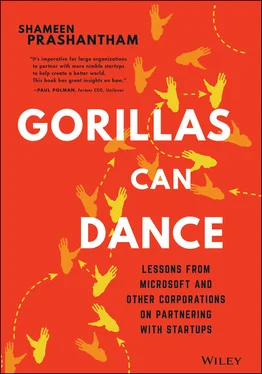Before getting into my narrative, I wish to make it clear that I am a neutral observer; despite the warm professional relationship I have had with many current and former Microsoft managers, I deliberately declined taking on any commercial or consulting role while my research was ongoing, a stance that has been graciously accepted by all my informants. (This holds for all the other companies I've studied for this book, as well.)
In presenting my account of Microsoft's startup journey, I describe three broad phases (see Figure P.1). The first culminates with the launch in 2008 of BizSpark, Microsoft's large-scale programmatic initiative to engage with young startups; that was also the year Bill Gates exited day-to-day operations at Microsoft, leaving Steve Ballmer fully in charge. The second phase covers subsequent startup partnering initiatives that had a global footprint, including an accelerator program originating in Israel, and were brought under a single umbrella, Microsoft Ventures, in 2013. The third begins around 2014, when Satya Nadella became CEO, when startup partnering had become increasingly “mainstreamed” into Microsoft's corporate strategy. 2

Figure P.1Three Phases of Microsoft's Startup Partnering Journey
PHASE 1 GETTING STARTUP PARTNERING OFF THE GROUND
Recognizing the Imperative to Partner with Startups
Following my first contact with Microsoft in 2003, the year it became the most valuable company in the world, 3 I had the opportunity to talk to Microsoft managers who were reaching out to the software developer community. Their goal was to co-opt independent software vendors (ISVs) as Microsoft partners. If these companies built their software products on top of Microsoft tools, then there was a win-win situation every time that company sold its offerings, since Microsoft technology would, in effect, be bundled with it. A prominent name that kept coming up in my interactions with these managers was that of Dan'l Lewin.
Back then, Lewin was a relative newcomer to Microsoft – a Silicon Valley insider who'd been around for a couple of years in a company that many viewed as a Silicon Valley outsider. Lewin's professional background made him better suited than most to connect Microsoft with the Valley. Lewin had worked at Apple as a member of the original team that designed, built, and marketed the Macintosh, an initiative that Steve Jobs described as intrapreneurship, and was hand-picked by Jobs when he left Apple to set up NeXT Inc. 4 In the years that followed, Lewin got involved in entrepreneurial ventures of his own, and had credibility in the Silicon Valley startup community. Later, in late December of 2000, he contacted Steve Ballmer and offered to help Microsoft build bridges with Silicon Valley, based on Ballmer's speech committing Microsoft to web standards, which he believed were going to be critical to realize the company's goal of becoming a software enterprise powerhouse; he says: “I sent Steve Ballmer an email, and I said, ‘If you're serious about … want[ing] to engage the start-up and venture capital community, I'd be interested in talking.’” 5
Ballmer acted swiftly. In January 2001, Lewin was hired as an officer of the company and, as a corporate vice president, had executive and site responsibility for the company's operations in Silicon Valley and the mandate to change how the company engaged the venture capital community and entrepreneurs and to resolve technical and business conflicts with the industry. In the aftermath of the dot-com boom and the lingering US Department of Justice (DOJ) anti-trust settlement, this was an important hire for Microsoft.
To better understand why Lewin's arrival at Microsoft in 2001 was significant, it is useful to take a step back and look at what Microsoft had been dealing with in the runup to Lewin joining the company. I am not a business historian, but looking back, developments at Microsoft in the late 1990s suggest that certain seeds were sown then that had a long-term impact.
The second half of the 1990s had been a complex period for Microsoft in at least three ways. First, the Internet had produced a “tidal wave” 6 that Microsoft was late to catch, but eventually did. Second, there was turbulence as the company had to deal with an anti-trust lawsuit brought by the US DOJ. 7 Third, as noted in a memo known as the “Halloween papers,” 8 Microsoft faced the threat of being disrupted by the open source software movement. The last-mentioned was particularly crucial given the emergent platform strategy that culminated in the 2002 release of .NET, as Microsoft sought to transform itself into an enterprise software company in the post-dot-com era. The platform “evangelists” were seeking to get B2B independent software vendors (ISVs) to work on Microsoft platform technology and create enterprise solutions. Startups constituted a potentially important set of platform adopters, but there was a sense of disconnectedness between Microsoft and startups, notably in Silicon Valley, before Lewin arrived on the scene.
Operating out of Microsoft's Silicon Valley campus in Mountain View, California, Lewin went about establishing Microsoft's worldwide venture capital and startup community engagement efforts. 9 Lewin and his team began the groundwork for a partner program that would become BizSpark (discussed later) and related Microsoft Innovation Centers 10 across six continents in over 150 locations. This was going to be a marathon, not a sprint. Lewin had a formidable network in Silicon Valley, and in the early days of my research, Silicon Valley entrepreneurs took Lewin seriously but were still reserving judgment about Microsoft. Microsoft's power, because of its user base, was undeniably considerable; it couldn't be ignored. But the company was not perceived as being “cool.” At a Microsoft event in California, one Silicon Valley entrepreneur quipped to me during the lunch break: “That was like watching my dad dance …” Microsoft may have been grudgingly respected, but it certainly wasn't loved in Silicon Valley.
But further afield, Microsoft managers were getting the message that attracting great startups onto their platform was important. Essentially, this was a period of learning for Microsoft as it figured out how to partner with startups. In the mid-2000s this was happening within the generic framework infrastructure of partnering with ISVs, since a partner program customized for startups – which would appear as BizSpark – was still in the future.
Beginning to Partner with Startups (within a Generic Partner Framework)
Microsoft's partnership with a startup called Skelta was one of the early striking examples that I came across of a mutually beneficial partnership that took place even before there was a startup-friendly partnering program – with the emphasis on being more of a partner than a vendor.
In 2004, an early decision made by the founders' of Bangalore-based Skelta was to build its business process management (BPM) software products on Microsoft's .NET platform technology. They were thus betting on Microsoft's user base among enterprise customers that also constituted Skelta's target market. Having attracted a returnee with extensive experience in software product companies, Sanjay Shah, to be the CEO of the new venture, Skelta aggressively pursued a close working relationship with Microsoft's subsidiary in Bangalore.
During 2005, Microsoft India was highly supportive because it felt that Skelta had proved to be a valuable and loyal partner. Skelta was given significant exposure to thought leaders within Microsoft and enhanced Skelta's visibility in Microsoft beyond its India operations. Shah knew that Microsoft managers in India were pleased to have, in Skelta, a good example for internal and external audiences of its efforts to partner with Indian companies. As noted by Rajiv Sodhi, COO of Microsoft India, who was then the Microsoft manager who had been instrumental in fostering the relationship with Skelta under the auspices of the ISV program,
Читать дальше













